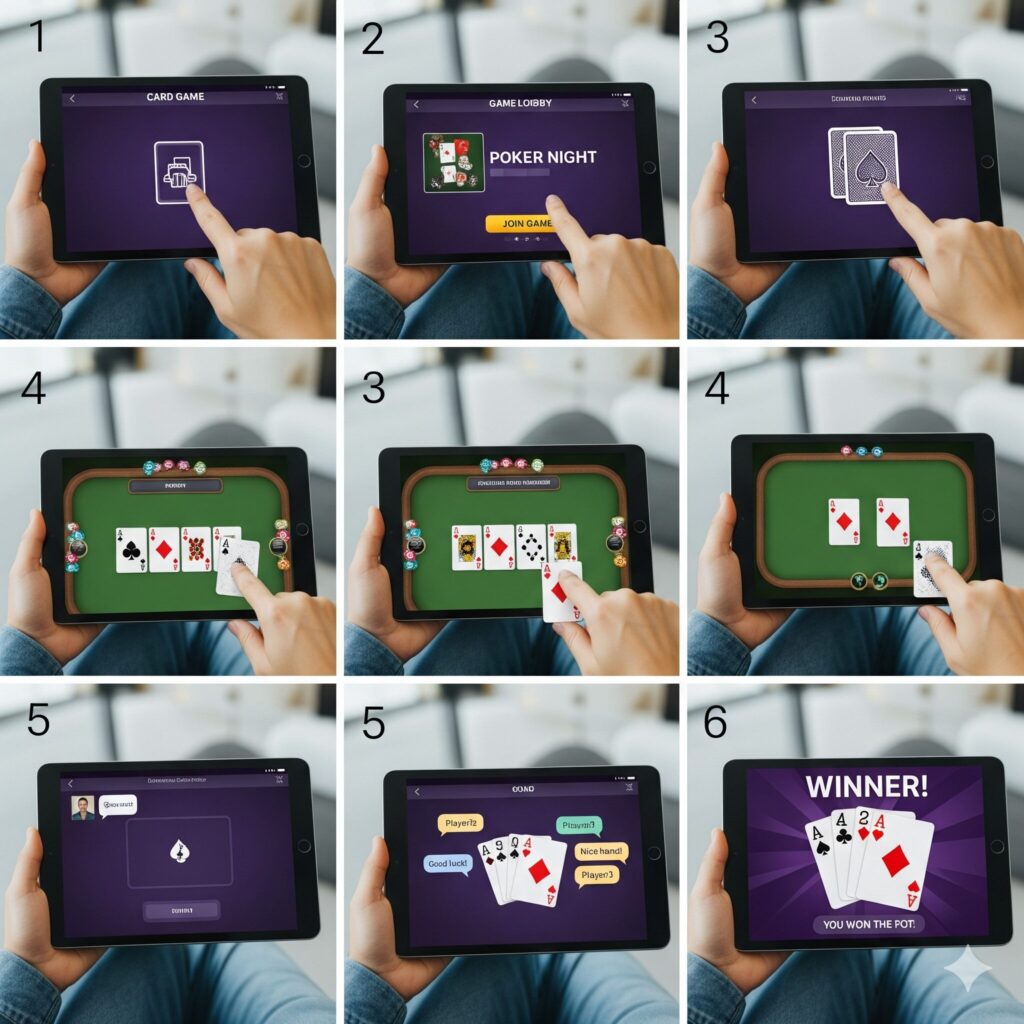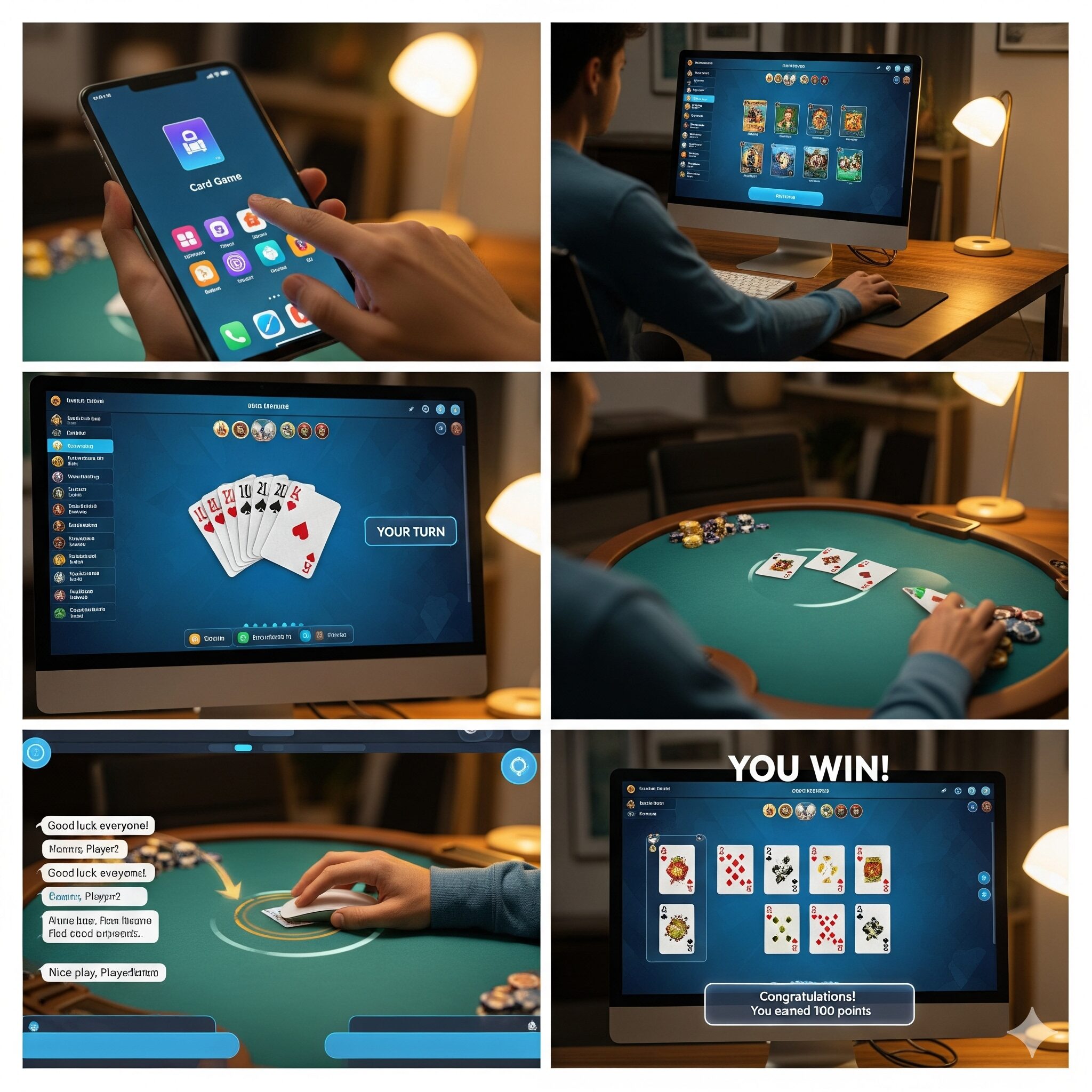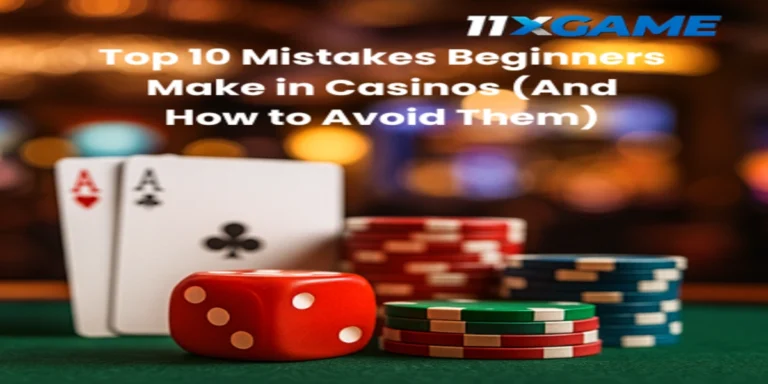How to Play Card Games Step by Step : Beginner’s Ultimate Guide

How to Play Card Games Step by Step :-
Want to learn card games the simple, smart, and step-by-step way? You’re in the right place. This pillar guide takes you from the very basics to confident gameplay, covering popular card game types such as Rummy, Blackjack, Poker/Teen Patti, along with matching and shedding games.”You’ll learn the lingo, setup, rules framework, strategy flow, and common mistakes to avoid. It’s written in clear, Indian English for quick understanding and smooth practice.
If you prefer playing online, 11xgame makes it super easy to explore different card games with tutorials, fair play tools, and beginner-friendly tables.
What You’ll Learn
- How a standard deck works (suits, ranks, values).
- The universal steps to learn any card game.
- “Skeleton rules” you can adapt to different games.
- Step-by-step mini-guides for Rummy, Blackjack, Poker/Teen Patti.
- Practical tips, etiquette, and responsible play.
- Quick reference: cheat sheets, glossary, FAQs.
Card Game Basics in 60 Seconds
- Deck: Most classic games use 52 cards (4 suits—♠, ♥, ♦, ♣; 13 ranks—A,2–10,J,Q,K).
- Card Values: Face cards (J,Q,K) often = 10; Aces can be 1 or 11 (depends on the game).
- Objective Types:
- Trick-taking (win rounds—e.g., Hearts).
- Matching/Meld-building (make sets/runs—e.g., Rummy).
- Shedding (get rid of all cards—e.g., UNO-style).
- Comparing (hand strength—e.g., Poker, Teen Patti).
- Total-count (reach a target—e.g., Blackjack = 21).
- Turn Flow: Deal → Play/Draw → Discard/Act → Score → Repeat → Win condition.
Pro tip: Read the objective first. Once you know what “counts as winning,” rules make instant sense.
The Universal 10-Step Method to Learn Any Card Game
Use this scaffold to master new games quickly:
- Name & Players
Note ideal player count, partnership rules (solo/teams), and whether dealer rotates. - Deck & Setup
52-card standard or custom? Jokers used? Number of cards dealt to each player? Any table layout (discard pile, stock pile, trump card, community cards)? - Objective (Win Condition)
E.g., make melds first (Rummy), reach 21 without busting (Blackjack), best 5-card hand (Poker), be the first to shed all cards, or win most tricks. - Card Values & Special Rules
Aces high or low? Wild cards/Jokers? Points for sets, runs, or penalties? - Turn Structure
What happens on your turn—draw/play/discard? Can you pick from discard or only stock? Are there mandatory actions? - Actions Allowed
“Can you take actions like knocking, showing, melding, betting, calling, raising, folding, doubling, or splitting? Any table talk limits or timing rules? - Scoring
How to tally points or chips after each hand/round. Are there bonuses (pure sequences, blackjacks) or penalties (deadwood)? - End of Round
What triggers the end—someone goes out, cards finish, point cap reached, or time limit? - End of Game
First to a target score, best of fixed rounds, or last player standing. - Etiquette & Safety
Shuffle fairly, act in turn, no signalling. If playing online, use features like practice lobbies, table limits, and hand histories. On 11xgame, you can practise at low-stakes tables and review hands for fast improvement.
Core Skills: Shuffle, Deal, Read, Decide
- Shuffle Like a Pro: Overhand (simple), riffle (casino-style), or Hindu shuffle (popular in India). Cut the deck before dealing.
- Deal Consistently: Same number of cards per player, clockwise or anti-clockwise as per the game.
- Table Reading: Watch discards, track exposed melds, notice betting patterns (in comparing games).
- Decision Ladder:
- What’s my best objective path right now?
- What helps the objective this turn?
- What hurts opponents most (blocking cards, pressure bets)?
- What’s the safest fallback if things go wrong?
Step-by-Step Mini-Guides for Popular Games
A) Rummy (Indian Rummy 13 Cards)
Objective: Create valid sets (like 7♥-7♣-7♠) and sequences/runs (like 5♣-6♣-7♣). At least one sequence must be pure, meaning it cannot include a Joker.” Setup:
- Deck(s): Commonly 2 decks + Jokers for multiple players.
Deal: Each player gets 13 cards, with one open discard pile and one closed stock pile placed on the table.
Turn Flow (Step by Step):
- Draw: Take one card from the stock pile (face-down) or the discard pile (face-up).”
- · Plan Melds: Focus on creating a pure sequence first—it lowers penalty points and makes it easier to build the rest of your combinations.
- Joker Use: After your pure sequence, use Jokers to complete other sets/runs.
- Discard: End your turn by discarding one card.
- Show/Declare: When ready with valid combinations (with at least one pure sequence), declare. Opponents validate.
Scoring Basics:
- Face cards (J, Q, K) count as 10 points, Ace is generally valued at 10 in common versions, and all other cards are worth their printed numbers.
- Losers count points of un-melded cards (deadwood). Lower is better.
Beginner Mistakes & Fixes:
- Mistake: Holding high cards too long.
“Fix: Discard high cards like K, Q, J, or A early—unless they’re helping you complete a sequence.” - Mistake: Ignoring opponent’s discards.
Fix: Track what they pick—don’t feed needed cards. - Mistake: Declaring without a pure sequence.
Fix: Lock pure sequence first, always.
Platforms like 11xgame provide practice tables where you can learn sequences at your own pace with clear visuals.
B) Blackjack (21)
Objective: Defeat the dealer by getting a hand total closer to 21 than theirs, without going over 21 (busting). Card Values:
- 2–10 = pip value; J/Q/K = 10; Ace = 1 or 11 (best for you).
Round Flow (Step by Step):
- Place Your Bet (or Set Your Stake in Practice).
- Initial Deal: You get two cards; dealer gets two (one face-up, one face-down).
- Player Options:
- Hit: Take a card if your total is low.
- Stand: Hold your total if you’re strong.
- Double: Double stake, take exactly one card (usually on 9–11).
- Split: If pair (like 8-8), split into two hands (house rules apply).
- Dealer Acts: Dealer reveals hole card and hits until a fixed total (commonly 17).
- Payout: You win when your hand total is higher than the dealer’s without going over 21.”
- A ‘blackjack’ (an Ace with a 10-value card) typically pays extra.”
- Basic Strategy Mindset: Hit hard on very low totals (e.g., 8 or less).
On 12–16, your decision depends on the dealer’s upcard—stand if dealer shows 2–6 (they might bust), hit if dealer shows 7-A. Strategy tip: Always split Aces and 8s, but avoid splitting 5s or 10s.”
On 11xgame, basic-strategy helpers and hand histories are handy for polishing decisions while keeping play responsible.
C) Poker (Texas Hold’em) & Teen Patti (Comparing Games)
Shared Idea: You’re competing on hand strength and decision-making (fold/call/raise). Community vs no-community is the key difference.
Texas Hold’em (Quick Start) Goal: Combine your two hole cards with the five community cards to form the strongest 5-card hand.
Flow:
- Pre-flop: You receive 2 private cards. Decide to fold/call/raise based on strength and position.
- Flop: 3 community cards revealed; reassess your hand and draws.
- Turn: 4th community card; pot odds become crucial.
- River: 5th card; final bets. Best 5-card hand wins (or everyone else folds).
Starter Tips:
- Play tight from early position (strong hands only).
- Value bet made hands; don’t chase weak draws without good odds.
- Watch opponents—do they bet strong only with monsters or also as bluffs?
When you practise on 11xgame, start at beginner tables and review hand histories to understand why a decision was profitable or not.
Teen Patti (3-Card)
Objective: Highest-ranking 3-card hand wins (trio/straight flush/straight/flush/pair/high card).
Flow:
- Ante/Boot: Everyone posts a small starting stake.
- Deal: 3 cards to each, face-down.
- Betting: Play “blind” or “seen,” matching/raising as per table minimums. You may pack (fold) if weak.
- Showdown: Remaining players compare hands; highest wins the pot.
Starter Tips:
- Play fewer but stronger starting ranges (e.g., high pairs, connected high cards).
- Don’t “chase” every pot. Conserve chips for good edges.
- Read table dynamics—tight tables reward selective aggression.
Try a free table on 11xgame to learn pacing and bet sizing without pressure.
Matching & Shedding Games (Family Blueprint)
Matching (e.g., Go Fish, Memory):
- Goal: Collect pairs/sets by asking for ranks or flipping to remember positions.
- Skill: Memory and probability—track what others asked or revealed.
Shedding (e.g., UNO-style, Crazy Eights):
- Goal: Play all your cards by matching number/colour/suit or using special actions.
- Skill: Hand management—save “outs” for tricky turns; disrupt opponents with timely action cards.
Why We Choose Card Games (Simple Reasons That Matter)
- Easy to Start, Hard to Master: You can learn in minutes and keep improving for years.
- Brain Benefits: Memory, probability, patience, emotional control.
- Social Vibe: Family game nights, hostel common rooms, office breaks—cards connect people.
- Portable Fun: A single deck = dozens of games. Online tables = instant matches.
- Skill Over Luck (Long Run): Especially in Rummy and Poker, decisions compound into edges.
- Flexible Stakes: Play free, play points, or friendly chips—your call.
- Short or Long Sessions: Sprint a few hands or settle in for a full evening.
- Clear Progress: Hand histories and tracking show your growth curve.
Want to speed up your learning loop? Structured practice, table limits, and clear tutorials on 11xgame help you build confidence step by step.
Beginner Mistakes & Quick Fixes
- Playing Every Hand: Be selective. Fold weak starts; protect chips/cards for better spots.
- Not Knowing Priority: In Rummy, secure your pure sequence first; in Blackjack, follow basic strategy; in Poker/Teen Patti, position matters.
- Ignoring Others: Watch discards (Rummy), dealer upcard (Blackjack), betting patterns (Poker/Teen Patti).
- Tilt (Emotional Play): Take a break after a big loss/win. Reset before continuing.
- Rules Drift: Confirm house rules before starting—A high or low? Jokers? Minimum raises? Showdown rules?
Pro Tips That Compound
- Build Playbooks: Keep a small notebook or digital note—starting ranges, common odds, rummy layouts you like.
- Use the 70% Rule: If your action doesn’t feel ≥70% correct, pause and reconsider.
- Reverse Planning: In Rummy, picture your final melds first; in Poker, plan for later streets from the start.
- Count Outs: Estimate how many cards help you (e.g., open-ended straight = 8 outs).
- Endgame Awareness: When points or chips get shallow, tighten up and favour high-EV plays.
- Review & Improve: Revisit key hands; ask “What was my mistake? What was my edge?” Tools on 11xgame make this reflective loop simple.
Responsible Play & Safety First
- Age & Legality: Play only if you’re of legal age and it’s permitted in your area.
- Limits: Pre-decide time and money limits; stick to them.
- Environment: Choose well-lit, calm spaces—distractions cause errors.
- Security: Use strong passwords and 2-factor authentication for online accounts.
- Fair Play: Respect table etiquette; no collusion or signalling.
Set gentle reminders and session timers on 11xgame so practice stays healthy and fun.

Quick Cheat sheets
Rummy Checklist
- Build a pure sequence first
- Use Jokers only after pure sequence
- Track opponent picks from discard
- Discard high-value singles early
Blackjack Checklist
- Hit ≤ 8; be careful with 12–16 vs dealer’s upcard
- Stand more vs dealer 2–6
- Split A,A and 8,8; never split 10s
- Double on many 10/11 totals (check table rules)
Poker/Teen Patti Checklist
- Choose strong starts; fold weak
- Position = power—act later, win more
- Bet with purpose (value or bluff)
- Protect stack; avoid ego calls
Mini Glossary (Plain Speak)
- Ante/Boot: Small forced bet to start a pot.
- “Blind: A required bet in Poker placed before the deal begins.”
- Call/Raise/Fold: Match bet/increase bet/give up hand.
- Hit/Stand/Double/Split: Blackjack actions—take a card/hold/double stake & take one card/split a pair into two hands.
- Meld: A valid set or run in Rummy.
- Outs: Cards that improve your hand to likely winner.
- Pot Odds: Ratio of current pot to the cost of a contemplated call.
- Sequence (Run): Consecutive cards of the same suit.
- Set: Same rank, different suits (e.g., 9♠-9♥-9♦).
FAQs
Q1. What’s the easiest card game to start with?
Matching and shedding games are the simplest; after that, try basic Rummy, then Blackjack.
Q2. How long does it take to learn?
You can learn rules in 10–15 minutes. Mastery comes from repetition and review.
Q3. Do I need two decks for Rummy?
For 4–6 players, two decks with Jokers is common; for fewer players, single-deck variants exist.
Q4. Is Poker luck or skill?
Short term has luck; long term rewards skill—hand selection, position, and bet sizing.
Q5. How do I stop “tilt”?
Set session limits, take 5-minute breaks, and review only when calm. If emotions rise, pause play.
Q6. Any quick upgrade to improve fast?
Track mistakes, study one concept per day, and practise at beginner tables online with clear tutorials—11xgame has friendly options for this.
Final Word
Card games reward calm thinking, patient practice, and small daily improvements. Start with the universal 10-step method, pick one game to focus on this week, and keep your sessions short and purposeful. If you want a smooth online experience with beginner-friendly tools and fair play, 11xgame is a safe pick to get you started and growing with confidence.






